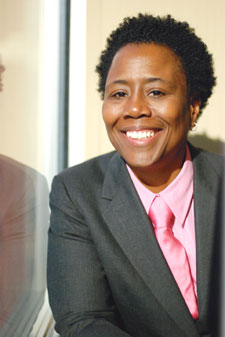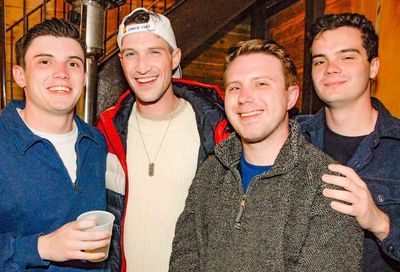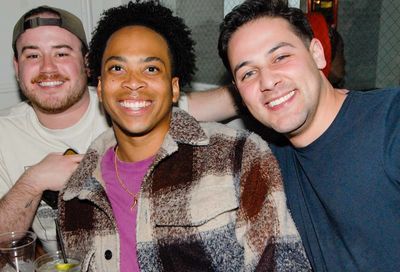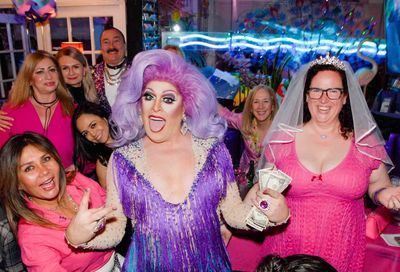Working the Numbers
2010 Census makes a hard-to-measure move toward gay visibility
When people hear about census-taking this time of year, it usually involves the story of Joseph and Mary trekking to Joseph’s hometown of Bethlehem to be counted for a census called for under the Roman Emperor Augustus.
The 2010 U.S. Census probably won’t secure as profound a place in history. It may nonetheless have some impact on the future of American society, with a particular nod to gay Americans.
Just how great a nod is open to debate.
From Darlene Nipper, the D.C.-based deputy executive director of the National Gay and Lesbian Task Force: “I think it’s a big step. I hope our community will not underestimate it.”
On the other hand, Mara Keisling, executive director of the National Center for Transgender Equality (NCTE), working out of the same Thomas Circle office building as Nipper, has a different view.

Darlene Nipper
(Photo by Todd Franson)
“It in no way counts LGBT people. It doesn’t even pretend to count trans people,” she says. “I don’t think we’re making much progress at all from 2000.”
The debatable progress compared to the 2000 Census, a national tally that attempts to count all Americans every 10 years, regards same-sex couples. In 2000, those same-sex couples that identified themselves as married were edited out and reclassified as unmarried, cohabitating same-sex couples. The change for 2010 is that those same-sex couples answering that they are married will be counted as such.
Fernando Armstrong, the U.S. Census Bureau’s regional director for the mid-Atlantic region that includes D.C., has been with the bureau since the late 1970s. The 2010 Census will be his fourth. And he says this change is definitely progress.
“In 2010 we will be able to report same-sex households in ways we never have before,” he says. “This is a unique opportunity.”
What this data of married same-sex couples will illustrate is uncertain. What exactly will be done with the data is also uncertain. Armstrong, Keisling and Nipper do, however, agree that any additional data about gay Americans is progress.
“Folks will say, ‘What about all of us? The “marrieds” are such a small number,'” Nipper acknowledges. “But we’ve gotten the bureau to see the importance of counting us, to making us visible. It’s an important first step. I think it’s huge. It’s a conscientious, deliberate, focused first step toward appropriately reflecting our community. The 2000 Census was sort of an inadvertent step, which we used to get information about ourselves. But this is different, very conscientious. It’s an action being taken jointly between the bureau and the community leaders who’ve worked on this.”
Keisling grants, “It’s one way of getting a number — that we know is a low number.”
Or, as Armstrong puts it, it’s movement toward getting a genuine count of LGBT Americans eventually.
”We need to keep in mind that things are changing in America,” he says. “We, the Census Bureau, we have always tried to adapt the census to how America is changing. I think for the census in 2020, there is a strong possibility that the questions to be included will be more encouraging of other types of arrangements.
“… It’s not too early for the LGBT community to communicate with their members of Congress about what they feel the form in 2020 should ask for. It takes a number of years to decide on the questions.”
The primary reason for a national census is apportionment of the House of Representatives. That’s why the Congress is responsible for approving the questions, just 10 total in 2010. And with hundreds of politicians in the mix, it’s a foregone conclusion that any tweak — much less a question about sexual orientation or gender identity — to the census could be instantly controversial. Beyond the politics, the science also makes counting a country so much more complicated than “1, 2, 3….”
“Any kind of question going to be used has to be tested rigorously,” says Keisling, guessing it will be a daunting undertaking to find sound ways to count Americans who make up each letter of the LGBT acronym. “That takes time and a surprisingly large amount of money. And nobody really knows what the right question is. To count LGBT people, do we really want to add, ‘What is the sexual orientation of everyone in your household?’ It’s not as clear-cut as everyone would want it to be.”
While Keisling’s NCTE and Nipper’s Task Force are both part of the large number of organizations making up the Our Families Count coalition — with much of the work fueled by research from Gary Gates of The Williams Institute, UCLA School of Law — officially launched last month and pushing for LGBT visibility in the census, the Task Force itself has launched a project a bit more radical: Queer the Census.
Despite Nipper’s upbeat assessment of the 2010 tally, the Queer the Census (queerthecensus.org) literature is decidedly less optimistic.
“It’s crazy — the U.S. Census Bureau wants an accurate count of everyone in the country — but there’s no question in the survey that asks if you are lesbian, gay, bisexual or transgender,” reads the welcome message on the Queer the Census website. “LGBT people are basically invisible….”
The effort asks those who’d like a more reflective accounting to sign a petition directed at the Census Bureau asking for an inclusive count. The site also offers visitors stickers by mail to place on the backs of their census return envelopes. Under a banner reading, “It’s time to count everyone!” boxes allow people to check-off and identify themselves as lesbian, gay, bisexual, transgender or “straight ally.”
Another community issue that surfaces with the census any year is gender identity. Keisling reckons it may be a very long time till Congress allows an inclusive question about gender identity, but it already asks people to identify as male or female. The rule with the census is self-identification. That goes for marital status as well as gender. It may be easier, however, for same-sex couples without marriage licenses to define themselves as married than for some transgender people to force themselves into a “male” or “female” category. Leaving the question blank is certainly an option.
“It’s not the end of the world if they leave it blank, but it will most likely trigger a phone call,” says Armstrong. If that phone call ends without a commitment to binary gender, he explains that the question will simply be recorded as “refused,” and that should be the end of it.
But it’s not the end of the census. The 2010 forms are due to hit mailboxes in March. Then the whole process returns in 2020. Regardless of the questions, Keisling urges particularly those in locales with high concentrations of LGBT residents to fill out their census forms, simply to ensure those areas receive their representational and budgetary due.
For more information about Our Families Count, visit ourfamiliescount.org. For Queer the Census, visit queerthecensus.org. For general information about the 2010 Census, visit 2010.census.gov.
Support Metro Weekly’s Journalism
These are challenging times for news organizations. And yet it’s crucial we stay active and provide vital resources and information to both our local readers and the world. So won’t you please take a moment and consider supporting Metro Weekly with a membership? For as little as $5 a month, you can help ensure Metro Weekly magazine and MetroWeekly.com remain free, viable resources as we provide the best, most diverse, culturally-resonant LGBTQ coverage in both the D.C. region and around the world. Memberships come with exclusive perks and discounts, your own personal digital delivery of each week’s magazine (and an archive), access to our Member's Lounge when it launches this fall, and exclusive members-only items like Metro Weekly Membership Mugs and Tote Bags! Check out all our membership levels here and please join us today!






















